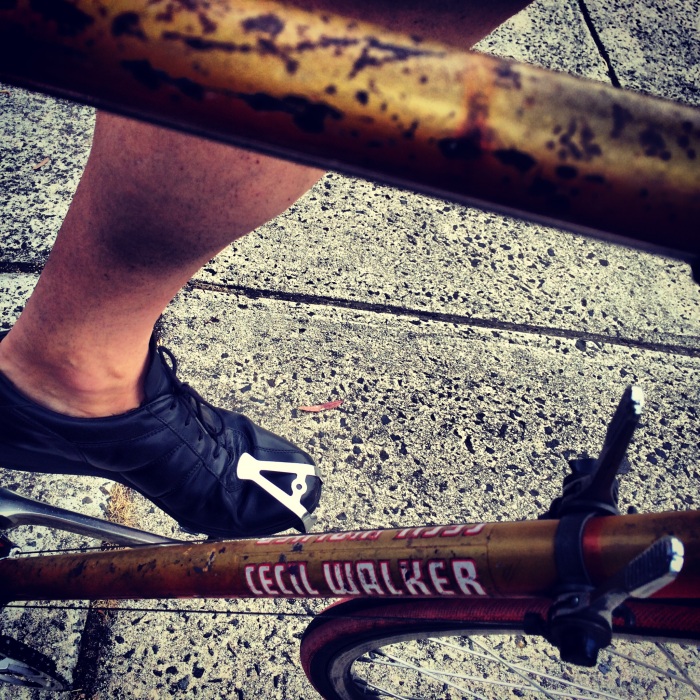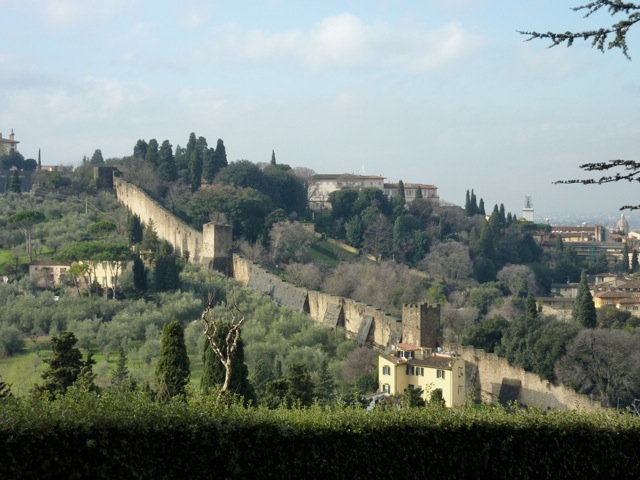It’s true. I love riding my carbon racing bike, Prince, and can be readily caught drooling over the latest Campagnolo groupsets and ultra lightweight carbon rims replete with technology inherited directed from the space program (or did NASA borrow it from the cycling industry? I can’t remember). But I’m also a man who loves the classics, not surprising for someone who’s spent the better part of the last two decades immersed in antiquity. But I mean old bikes not old books, bicycles from the heroic yesteryear of cycling. I still have two old steel bikes and they still get ridden.  One of them is now genuinely old, a Cecil Walker built in 1979 and fitted with what was then the standard Weinmann components from Switzerland, and a much later Cecil built for me in 1999 with Reynolds 531 tubing. It was my first bike with integrated brakes and gears, a Veloce Groupset and complete with Campagnolo Atlanta 96 rims. It was my pride and joy. I still ride both of them.
One of them is now genuinely old, a Cecil Walker built in 1979 and fitted with what was then the standard Weinmann components from Switzerland, and a much later Cecil built for me in 1999 with Reynolds 531 tubing. It was my first bike with integrated brakes and gears, a Veloce Groupset and complete with Campagnolo Atlanta 96 rims. It was my pride and joy. I still ride both of them.
I take the ’79 out on shorter local rides, up to 30km or so, but I have bigger things in store. I really want to use this to enter into L’eroica, a great event run in Tuscany with courses of up to 200km. What makes this special is that you have to ride a steel bike built before 1987. Some of the regulations include:
- road racing bikes, built before 1987 (not cycle-cross or time trial bikes);
- steel frame (the only aluminium frame bikes permitted are ALAN or VITUS with either screwed or glued joints);
- gear shift levers on the down tube of the frame (exceptionally, only pre-1980 bar-end gear shifts are allowed);
- pedals with toe clips and fitted straps (quick release pedals are not allowed, except Cinelli M71 pedals);
- passage of brake cables outside the handlebars (the passage of cables inside the frame is acceptable);
- wheels must have at least 32 spokes with a low profile (less than 20 mm).
(Source: L’eroica regulation from http://en.eroica.it/regulation)
Add to this that a good portion of the ride is on unsealed roads through the hills of Tuscany. It would be a real test of the bike as well as handling skills. The ride itself would be terrific, but imagine all that great food and wine as well!
- A view over the hills of Firenze.
The ’99 has become my commuter and backup training bike when the Prince is being serviced. I also use the ’99 to practice my mechanical skills on, like rebuilding the ergolevers which I did over Christmas. Only the other day I realised something very cool about the ’79 Cecil. It was the bike that got me into racing bikes in the first place when all my friends were riding BMXs.
I got into racers very young, while I was still at primary school, also riding Cecil Walkers and I did because that was what my step-dad rode – and the ’79 was his bike. He gave it to me when I finished school and needed a bike for my mobile car washing business in Sydney. It needed a lot of work and when I could afford it I gradually replaced most of the moving parts with good quality Shimano Ultegra components and some great Campagnolo Omega rims. Only a couple of months ago I rode it for the first time in ages and was amazed how good it felt. Getting into the hang of using down-tube shifters didn’t take long. The geometry felt so good that when I got home I started making lots of measurements to compare them with those on my Pinarello Prince. Interestingly, I also found it much easier to go into the drops and stay there on descents. Most surprisingly I also started getting some of my best times on my local hills on a bike that weighs twice that of my carbon beauty, and that was riding without cleats or even clips and in hiking shoes rather than my carbon-soled racing shoes. It’s a bit of a mystery.
Recently I’ve been thinking about whether to improve this bike, maybe install a nice old Campgnolo groupset, like the 50th anniversary edition with gold-plated details, or maybe the Cobolto or Delta, all beautiful groupsets and worth a pretty penny if you can find one in good condition. But what makes this bike special is our history.
The cranks for instance were bought after the originals snapped in two while riding up to a clients house in Bellevue Hill. I must have presented a pretty funny sight turning up at this mega mansion, having hauled my 15kg bike and a bag full of cleaning gear for the last couple of kms. I was late but I still got the job and he became my best client. After that I would regularly wander into my local bike shop which was run by a great French mechanic, Gilbert (at Gilbert’s Cyclery) and his daughter. I know they thought I was nuts buying good components for this bike. Once his daughter once told me “don’t spend any more money on this bike!” A couple of months ago I took it into my mechanic’s for an overhaul – he kindly referred to as Frankenstein. He was probably right! But hey, Cecil’s my Frankenstein. My Beautiful Frankenstein and he’s still got some moves.
In my next post I’ll look at a couple of vintage bikes that have taken my fancy. I’ll also share some of the sites that specialise in selling and /or restoring old bikes that I’m finding as I delve into the heroic era of cycling.







I understand your devotion to your classic bikes. I share the feeling for the 1972 Mercian Vincitore bike that I still ride now and then.